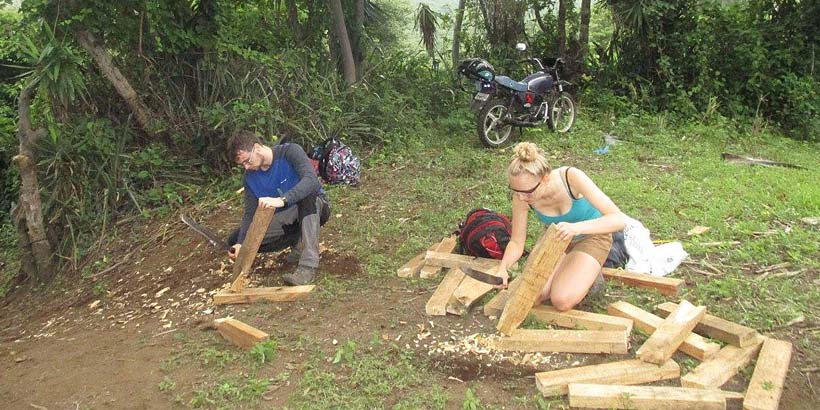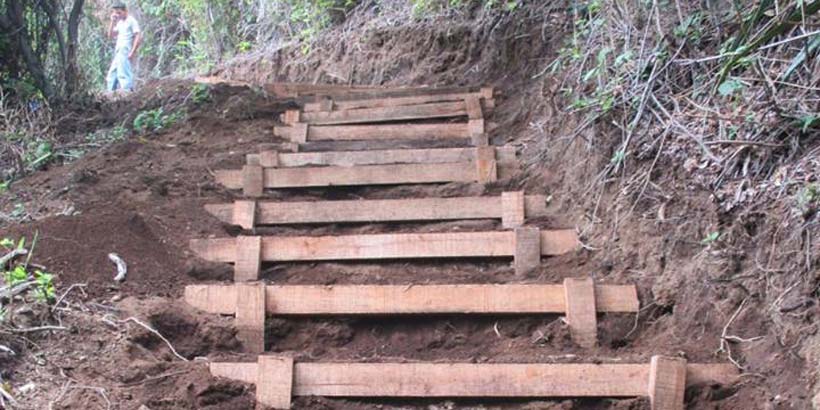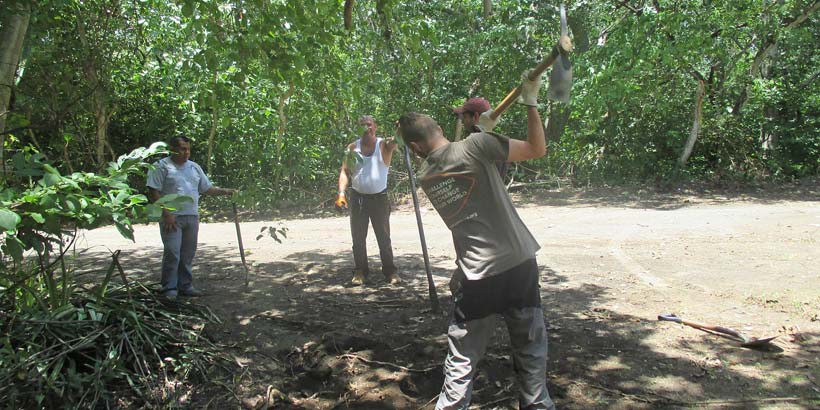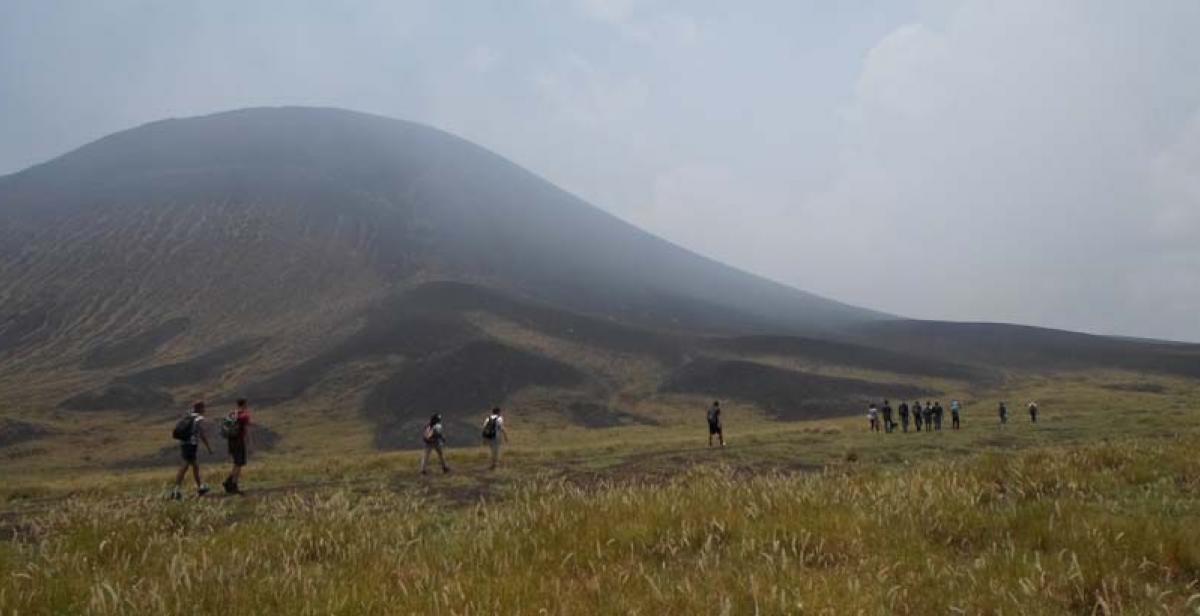Seeing as we are approaching the end of the cycle now and everyone is busy writing up reports and debriefs, I thought that this week would be a good time to reflect on the progress that we have made this cycle and everything that we have done in the National Park Volcan Masaya.
Our first task when we got here was to help build a viewpoint for the eco-farm. This was some really intense physical work carrying all of the materials needed to supply the locals building it. Mixing concrete by hand is no easy task either, but at the end of a tiring few days the whole team was really brought together as one with a nice early win seeing the completed viewpoint and looking out over the volcano and the solidified lava flows running into the forest below from it.

After this, we were assigned to building the steps leading up to the farm and the new viewpoint. The work was physically difficult as well, although a lot more skill was required in this task. During this project, the team learnt a whole host of construction skills. For me in particular, coming to the realisation that trying to whittle down stakes with a machete is not just a matter of brute force was a turning point, it probably should not take as many blisters as I ended up getting to realise that strong hands as well as arms are needed for this. At the same time, we were learning how to space and curve steps with a tape measure, allign them with a leveller and then how to form and compact them with spades. We were also shown by a park ranger how to make nails from huge lengths of thick wire. After the steps had been completed, the whole team had gained a huge amount of construction knowledge and what was previously an almost impassable steep sandy slope had been transformed into a (still very steep) well formed path that could be climbed relatively easily.

One of the highlights for me this trip has been my work on the marketing project for the cooperative. Although not everyone in the team got to work on this, I know that all the people that did feel really positive about the progress made on it. Over the course of this project the Aratinga cooperative has gone from not having a business plan, to having a well thought out plan with considerable steps taken to implementing it. During the project, several members of our team have taught the members of the cooperative computer skills to enable them to continue the work when we leave. A team of us also went out with a guide to take photos of the amazing landscapes around the park. We also took photos of cooperative guides giving tours to groups of people and these will all be used for the marketing of the cooperative. The best photos were used by us to make a brochure advertising the cooperative, their goals and the services that they offer. We also coordinated with local Central American University (UCA) students to set up social media sites for the cooperative and produced an English phrasebook for the guides to use when leading tours.
Another task that we were assigned was the landscaping of the eco-lodge. This work was challenging because of the vast amounts that we had to do cutting down overgrown areas, levelling the ground and building a path to the new information office for the cooperative. After this project, I am pleased to say that there has been massive progress in the aesthetic appeal of the eco-lodge and the information office, which will hopefully increase the satisfaction that tourists derive from visiting these features, leading to better reviews of the park and a higher influx of tourists.

The EU (European Union) project that commissioned the whole revamping of the park has seen huge progress, as we were only sent in to finish off the final stage of their plan. Their building of the eco-lodge will lead to a new shared source of income and jobs among the cooperatives in the park. When you combine this with the increased amount of tourist facilities that we have been able to facilitate with the cleaning and signposting of trails and the increased skills the guides now have due to ten weeks of hard work during the English lessons that we have provided for them, the park has been left with a capable workforce in the form of a new cooperative that can enhance the tourists’ experience of the park. The new jobs that have been created by this project will facilitate the locals moving away from unsustainable jobs cutting down timber and direct them to a stable occupation that is engaged in sustainable activities, such as planting trees and conserving the park, as well as boosting Nicaragua’s economy by encouraging tourism.
At the end of these ten weeks and the overall project of improving the National Park Volcán Masaya, it is easy to look back at all the progress that has been made and see the differences. I feel that although everyone is now tired and getting ready to wind down the project and go back to the UK or their homes in Nicaragua, the whole team can be proud of what they have achieved this cycle.
Written by ICS volunteer Tom Nevett
El progreso
Visto que estamos casi al final del ciclo y todo el mundo está escribiendo reportes, pensé que esta semana sería una buena oportunidad de considerar nuestro progreso durante el ciclo y todo lo que hemos hecho en el Parque Nacional Volcán Masaya.
Nuestra primera tarea cuando llegamos fue ayudar a construir un mirador para la eco-finca. Esto era un trabajo físicamente intenso, llevando todos los materiales para la construcción del local. Mezclar el cemento a mano no es una tarea muy fácil, pero al fin de unos días muy cansados, todo el equipo se unió con una temprana victoria viendo completado el mirador y disfrutando la vista sobre el volcán y los flujos de lava solidificados que fluyen desde el volcán hasta el bosque.
Después, construimos las escalinatas que conducen a la eco-finca y el nuevo mirador. Este trabajo era físicamente difícil también, pero esta tarea requirió más habilidades especializadas. Durante este proyecto, el equipo aprendió una gama de habilidades de construcción. Para mí en particular, dándome cuenta de que tratar de cortar los postes con un machete no es solamente una cuestión de fuerza, fue un punto de inflexión, no debería tomar tantas ampollas para darme cuenta de que se necesitan manos y brazos muy fuertes para este trabajo. Al mismo tiempo, aprendimos como espaciar y curvear las escalinatas con una cinta, alinearlas con un nivelador y como nivelarlas con una pala. También, un guarda parque nos mostró como clavar los clavos utilizando el alambre. Después de completar las escalinatas todo el equipo había ganado muchos conocimientos acerca de la construcción, y una colina muy agotadora se había transformado en un sendero que se puede subir fácilmente.
Una de las partes más memorables para mí ha sido el trabajo en el proyecto de mercadeo para la cooperativa. Aunque no todo el equipo tuvo la oportunidad de trabajar en esto, yo sé que todas las personas que tuvieron esta oportunidad se sienten muy positivas de su progreso. Durante este proyecto la cooperativa Aratinga ha hecho un plan de negocios muy desarrollado, y han tomado pasos considerables para implementarlo. También, unos miembros de nuestro equipo han enseñado a los integrantes de la cooperativa algunas habilidades de informática para que sigan trabajando cuando finalicemos. Un equipo fue a sacar fotos del paisaje increíble alrededor del parque con un guía. También, tomamos fotos de los guías haciendo un tour con los grupos de turistas, las cuales vamos a utilizar para el mercadeo de la cooperativa. Se utilizó las mejores fotos para hacer un folleto para la cooperativa, sus metas y los servicios que ofrecen. Además, coordinamos con estudiantes de la Universidad Centroamericana (UCA) la elaboración de páginas de media social para la cooperativa e hicimos un libro de frases en inglés para que los guías puedan utilizarlo cuando hagan los tours.
Otra tarea fue la jardinería del eco-albergue. Era un desafío a causa de la gran cantidad de trabajo que tuvimos que hacer – cortamos las partes descuidadas, nivelamos la tierra y construimos un nuevo sendero hacia la oficina de información de la cooperativa. Después de este proyecto, estoy contento de decir que ha habido mucho progreso en la apariencia estética del eco-albergue y la oficina de información; esperemos que esto incluya en la satisfacción de los turistas cuando visiten estos lugares, lo cual generara mejores comentarios acerca del parque e incrementará el flujo de turistas.
El proyecto de la UE (Unión Europea) que se encargó de las mejoras de infraestructura en el parque ha producido un progreso enorme, dado que hemos estado aquí para terminar las etapas finales de su plan. La construcción del eco-albergue conducirá a una fuente nueva de ingresos y empleos compartidos entre las cooperativas del parque. Cuando eso se combina con la cantidad incrementada de facilidades turísticas que hemos podido proveer – la limpieza y la señalización de los senderos, y las habilidades incrementadas de los guías debido a diez semanas de trabajo duro durante las clases de inglés que hemos hecho – hemos dejado el parque con una mano de obra capaz en la forma de una cooperativa nueva que puede mejorar la experiencia turística del parque. Los nuevos empleos que se han creado por el proyecto facilitarán que los locales se aparten de los trabajos insostenibles como cortar madera hacia una ocupación estable haciendo actividades sostenibles como plantar árboles y conservar el parque, y mejorará la economía nicaragüense promoviendo el turismo.
Al final de estas diez semanas y el proyecto del mejoramiento del Parque Nacional Volcán Masaya, es fácil reflexionar y ver las diferencias. Aunque ahora todo el mundo está cansado, el proyecto se termina y estamos preparándonos para regresar al Reino Unido o a nuestros hogares en Nicaragua, todo el equipo puede estar orgulloso de lo que hemos logrado durante este ciclo.
Escrito por el voluntario de ICS Tom Nevett



